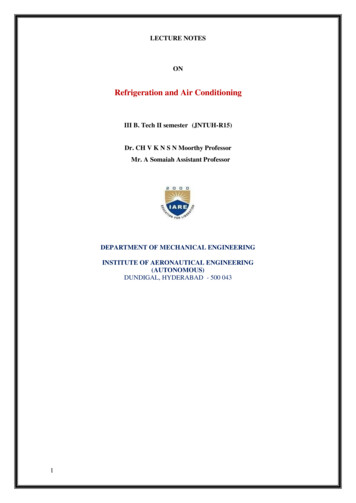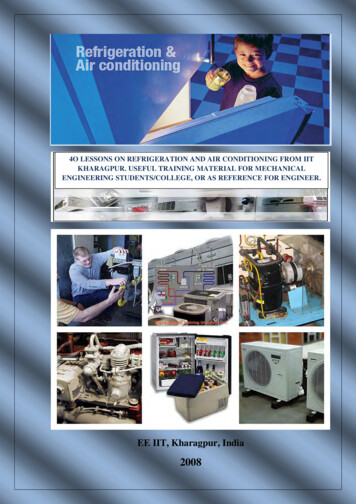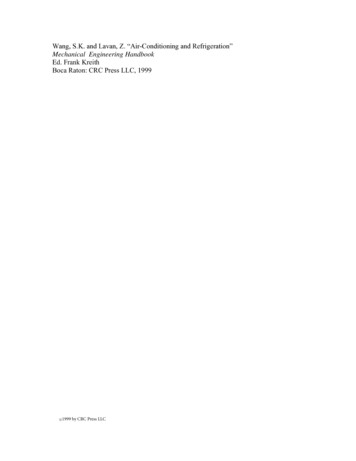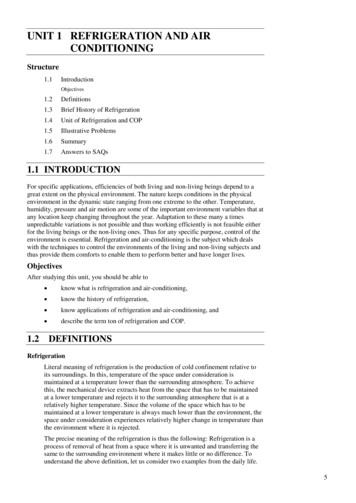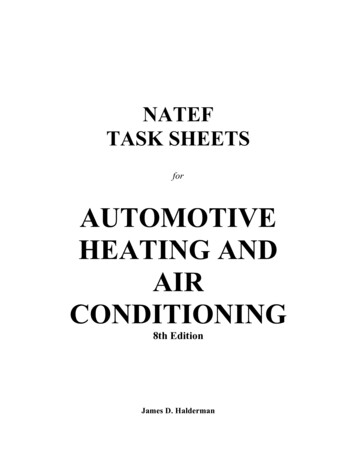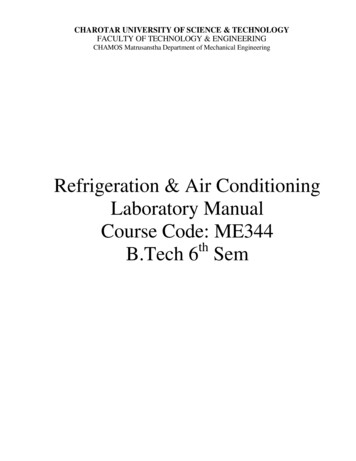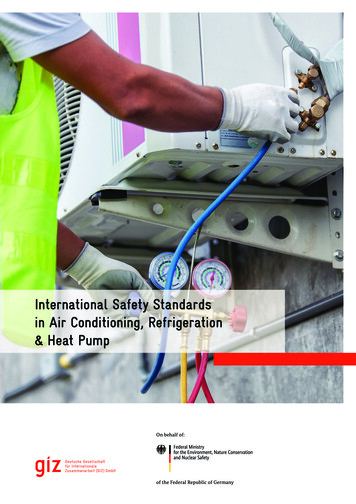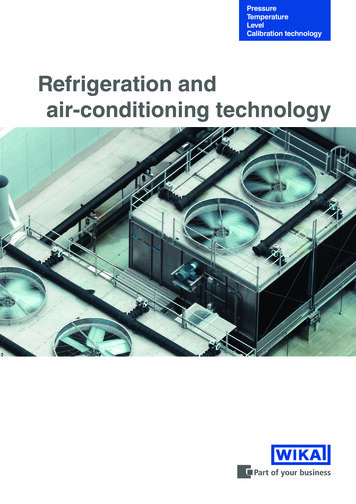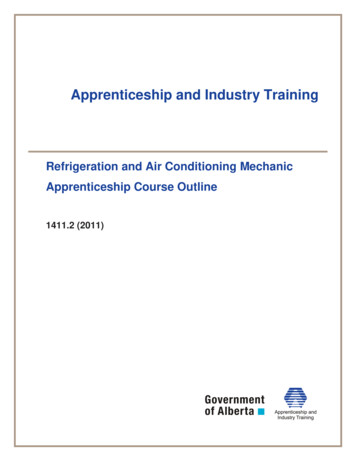
Transcription
Apprenticeship and Industry TrainingRefrigeration and Air Conditioning MechanicApprenticeship Course Outline1411.2 (2011)
ALBERTA ADVANCED EDUCATION AND TECHNOLOGY CATALOGUING IN PUBLICATION DATAAlberta. Alberta Advanced Education and Technology. Apprenticeship and Industry Training.Refrigeration and air conditioning mechanic : apprenticeship course outline.ISBN 978-0-7785-9320-1Available online: http://www.tradesecrets.gov.ab.ca/1. Refrigeration and refrigerating machinery – Maintenance and repair – Vocational guidance –Alberta.2. Air conditioning – Maintenance and repair – Vocational guidance – Alberta. 3. Apprentices - Alberta.4. Occupational training - Alberta. 5. Apprenticeship programs – Alberta. I. Title.II. Series: Apprenticeship and industry training.HD4885.C2.R47 A333 2011373.272011, Her Majesty the Queen in right of the Province of Alberta, as represented by the Minister of Alberta Advanced Educationand Technology, 10th floor, Commerce Place, Edmonton, Alberta, Canada, T5J 4L5. All rights reserved. No part of thismaterial may be reproduced in any form or by any means, without the prior written consent of the Minister of AdvancedEducation and Technology Province of Alberta, Canada. Revised 2011. Revised 2012.
Refrigeration and Air Conditioning MechanicTable of ContentsApprenticeship . 2Apprenticeship and Industry Training System . 2Apprenticeship Safety . 4Technical Training. 6Procedures for Recommending Revisions to Course Outline . 6Apprenticeship Route toward Certification . 7Refrigeration and Air Conditioning Mechanic Training Profile . 8Course OutlineFirst Period Technical Training .13Second Period Technical Training.22Third Period Technical Training.30Fourth Period Technical Training .36-1-
ApprenticeshipApprenticeship is post-secondary education with a difference. Apprenticeship begins with finding an employer.Employers hire apprentices, pay their wages and provide on-the-job training and work experience. Approximately80 per cent of an apprentice’s time is spent on the job under the supervision of a certified journeyperson orqualified tradesperson. The other 20 per cent involves technical training provided at, or through, a postsecondary institution – usually a college or technical institute.To become certified journeypersons, apprentices must learn theory and skills, and they must pass examinations.Requirements for certification—including the content and delivery of technical training—are developed andupdated by the Alberta Apprenticeship and Industry Training Board on the recommendation of Refrigeration andAir Conditioning Mechanic Technician Provincial Apprenticeship Committee.The graduate of the Refrigeration and Air Conditioning Mechanic apprenticeship training is a journeyman who will:xxxxxxxxxxsupervise, train and coach apprenticesuse and maintain hand and power tools to the standards of competency and safety required in the tradehave a thorough knowledge of the principle components of refrigeration systems, heat/cool units and air conditioninghave a thorough knowledge of the electrical and automatic controls used in all aspects of the refrigeration and airconditioning industrybe capable of assembling, installing or over hauling all componentshave an intimate knowledge of other mechanical trades, which contribute to refrigeration and air conditioning systemsbe proficient in the use of test instrumentsexercise good judgment and resourcefulness in construction, maintenance and workplace health and safetyknow, and be able to apply their knowledge of the installation, and service of HVAC systems in accordance with local,provincial and national standards for the industrydo all Refrigeration and Air Conditioning Mechanic tasks expected of a journeyman.Apprenticeship and Industry Training SystemIndustry-DrivenAlberta’s apprenticeship and industry training system is an industry-driven system that ensures a highly skilled,internationally competitive workforce in more than 50 designated trades and occupations. This workforce supportsthe economic progress of Alberta and its competitive role in the global market. Industry (employers andemployees) establishes training and certification standards and provides direction to the system through anindustry committee network and the Alberta Apprenticeship and Industry Training Board. The Alberta governmentprovides the legislative framework and administrative support for the apprenticeship and industry training system.Alberta Apprenticeship and Industry Training BoardThe Alberta Apprenticeship and Industry Training Board provides a leadership role in developing Alberta’s highlyskilled and trained workforce. The board’s primary responsibility is to establish the standards and requirementsfor training and certification in programs under the Apprenticeship and Industry Training Act. The board alsoprovides advice to the Minister of Advanced Education and Technology on the needs of Alberta’s labour marketfor skilled and trained workers, and the designation of trades and occupations.The thirteen-member board consists of a chair, eight members representing trades and four membersrepresenting other industries. There are equal numbers of employer and employee representatives.Industry Committee NetworkAlberta’s apprenticeship and industry training system relies on a network of industry committees, including localand provincial apprenticeship committees in the designated trades, and occupational committees in thedesignated occupations. The network also includes other committees such as provisional committees that areestablished before the designation of a new trade or occupation comes into effect. All trade committees arecomposed of equal numbers of employer and employee representatives. The industry committee network is thefoundation of Alberta’s apprenticeship and industry training system.-2-
Local Apprenticeship Committees (LAC)Wherever there is activity in a trade, the board can set up a local apprenticeship committee. The board appointsequal numbers of employee and employer representatives for terms of up to three years. The committeeappoints a member as presiding officer. Local apprenticeship committees:x monitor apprenticeship programs and the progress of apprentices in their trade, at the local levelx make recommendations to their trade’s provincial apprenticeship committee (PAC) about apprenticeshipand certification in their tradex promote apprenticeship programs and training and the pursuit of careers in their tradex make recommendations to the board about the appointment of members to their trade’s PACx help settle certain kinds of disagreements between apprentices and their employersx carry out functions assigned by their trade’s PAC or the boardProvincial Apprenticeship Committees (PAC)The board establishes a provincial apprenticeship committee for each trade. It appoints an equal number ofemployer and employee representatives, and, on the PAC’s recommendation, a presiding officer - each for amaximum of two terms of up to three years. Most PACs have nine members but can have as many as twentyone. Provincial apprenticeship committees:x Make recommendations to the board about:xstandards and requirements for training and certification in their tradexcourses and examinations in their tradexapprenticeship and certificationxdesignation of trades and occupationsxregulations and orders under the Apprenticeship and Industry Training Actx monitor the activities of local apprenticeship committees in their tradex determine whether training of various kinds is equivalent to training provided in an apprenticeshipprogram in their tradex promote apprenticeship programs and training and the pursuit of careers in their tradex consult with other committees under the Apprenticeship and Industry Training Act about apprenticeshipprograms, training and certification and facilitate cooperation between different trades and occupationsx consult with organizations, associations and people who have an interest in their trade and withemployers and employees in their tradex may participate in resolving certain disagreements between employers and employeesx carry out functions assigned by the boardx.Refrigeration and Air Conditioning Mechanic PAC Members at the Time of PublicationMr. Art McMullen . Red Deer . Presiding OfficerMr. Wayne Brilz . Calgary . EmployerMr. Lyn Doudiet . Edmonton . EmployerMr. Rod Dufresne . Okotoks . EmployerMr. Michael Harper . Sherwood Park . EmployeeMr. Shannon Malone . Edmonton . EmployeeMr. Craig Mathes . Calgary . EmployeeMr. Geoff Mitchell . Edmonton . EmployeeAlberta GovernmentAlberta Advanced Education and Technology works with industry, employer and employee organizations andtechnical training providers to:xfacilitate industry’s development and maintenance of training and certification standardsxprovide registration and counselling services to apprentices and employersxcoordinate technical training in collaboration with training providersxcertify apprentices and others who meet industry standards-3-
Technical Institutes and CollegesThe technical institutes and colleges are key participants in Alberta’s apprenticeship and industry training system.They work with the board, industry committees and Alberta Advanced Education and Technology to enhanceaccess and responsiveness to industry needs through the delivery of the technical training component ofapprenticeship programs. They develop lesson plans from the course outlines established by industry and providetechnical training to apprentices.Apprenticeship SafetySafe working procedures and conditions, incident/injury prevention, and the preservation of health are of primaryimportance in apprenticeship programs in Alberta. These responsibilities are shared and require the joint effortsof government, employers, employees, apprentices and the public. Therefore, it is imperative that all parties areaware of circumstances that may lead to injury or harm.Safe learning experiences and healthy environments can be created by controlling the variables and behavioursthat may contribute to or cause an incident or injury. By practicing a safe and healthy attitude, everyone canenjoy the benefit of an incident and injury free environment.Alberta Apprenticeship and Industry Training Board Safety PolicyThe Alberta Apprenticeship and Industry Training Board (board) fully supports safe learning and workingenvironments and emphasizes the importance of safety awareness and education throughout apprenticeshiptraining- in both on-the- job training and technical training. The board also recognizes that safety awareness andeducation begins on the first day of on-the-job training and thereby is the initial and ongoing responsibility of theemployer and the apprentice as required under workplace health and safety training. However the boardencourages that safe workplace behaviour is modeled not only during on-the-job training but also during allaspects of technical training, in particular, shop or lab instruction. Therefore the board recognizes that safetyawareness and training in apprenticeship technical training reinforces, but does not replace, employer safetytraining that is required under workplace health and safety legislation.The board has established a policy with respect to safety awareness and training:The board promotes and supports safe workplaces, which embody a culture of safety forall apprentices, employers and employees. Employer required safety training is theresponsibility of the employer and the apprentice, as required under legislation other thanthe Apprenticeship and Industry Training Act.The board’s complete document on its ‘Apprenticeship Safety Training Policy’ is available atwww.tradesecrets.gov.ab.ca; access the website and conduct a search for ‘safety training policy’.Implementation of the policy includes three common safety learning outcomes and objectives for all trade courseoutlines. These common learning outcomes ensure that each course outline utilizes common language consistentwith workplace health and safety terminology. Under the title of ‘Standard Workplace Safety’, this first section ofeach trade course outline enables the delivery of generic safety training; technical training providers will providetrade specific examples related to the content delivery of course outline safety training.-4-
AddendumAs immediate implementation of the board’s safety policy includes common safety learning outcomes andobjectives for all course outlines, this trade’s PAC will be inserting these safety outcomes into the main body oftheir course outline at a later date. In the meantime the addendum below immediately places the safety outcomesand their objectives into this course outline thereby enabling technical training providers to deliver the content ofthese safety outcomes.STANDARD WORKPLACE SAFETYA.Safety Legislation, Regulations & Industry Policy in the Trades .Outcome:B.1.Demonstrate the ability to apply the Occupational Health and Safety Act, Regulation and Code.2.Explain the role of the employer and employee in regard to Occupational Health and Safety(OH&S) regulations, Worksite Hazardous Materials Information Systems (WHMIS), fireregulations, Workers Compensation Board regulations, and related advisory bodies and agencies.3.Explain industry practices for hazard assessment and control procedures.4.Describe the responsibilities of workers and employers to apply emergency procedures.5.Describe positive tradesperson attitudes with respect to housekeeping, personal protectiveequipment and emergency procedures.6.Describe the roles and responsibilities of employers and employees with respect to the selectionand use of personal protective equipment (PPE).7.Select, use and maintain appropriate PPE for worksite applications.Climbing, Lifting, Rigging and Hoisting .Outcome:C.Describe legislation, regulations and practices intended to ensure a safe work place in thistrade.Describe the use of personal protective equipment (PPE) and safe practices for climbing,lifting, rigging and hoisting in this trade.1.Select, use and maintain specialized PPE for climbing, lifting and load moving equipment.2.Describe manual lifting procedures using correct body mechanics.3.Describe rigging hardware and the safety factor associated with each item.4.Select the correct equipment for rigging typical loads.5.Describe hoisting and load moving procedures.Hazardous Materials & Fire Protection .Outcome:Describe the safety practices for hazardous materials and fire protection in this trade.1.Describe the roles, responsibilities features and practices related to the workplace hazardousmaterials information system (WHMIS) program.2.Describe the three key elements of WHMIS.3.Describe handling, storing and transporting procedures when dealing with hazardous material.4.Describe safe venting procedures when working with hazardous materials.5.Describe fire hazards, classes, procedures and equipment related to fire protection.-5-
Workplace Health and SafetyA tradesperson is often exposed to more hazards than any other person in the work force and therefore should befamiliar with and apply the Occupational Health and Safety Act, Regulations and Code when dealing withpersonal safety and the special safety rules that apply to all daily tasks.Workplace Health and Safety (Alberta Employment, Immigration and Industry) conducts periodic inspections ofworkplaces to ensure that safety regulations for industry are being observed.Additional information is available at www.worksafely.orgTechnical TrainingApprenticeship technical training is delivered by the technical institutes and many colleges in the public postsecondary system throughout Alberta. The colleges and institutes are committed to delivering the technicaltraining component of Alberta apprenticeship programs in a safe, efficient and effective manner. All trainingproviders place great emphasis on safe technical practices that complement safe workplace practices and help todevelop a skilled, safe workforce.The following institutions deliver Refrigeration and Air Conditioning Mechanic apprenticeship technical training:Northern Alberta Institute of TechnologySouthern Alberta Institute of TechnologyProcedures for Recommending Revisions to the Course OutlineAdvanced Education and Technology has prepared this course outline in partnership with the Refrigeration andAir Conditioning Mechanic Provincial Apprenticeship Committee.This course outline was approved on December 9, 2010 by the Alberta Apprenticeship and Industry TrainingBoard on a recommendation from the Provincial Apprenticeship Committee. The valuable input provided byrepresentatives of industry and the institutions that provide the technical training is acknowledged.Any concerned individual or group in the province of Alberta may make recommendations for change by writingto:Refrigeration and Air Conditioning Mechanic Provincial Apprenticeship Committeec/o Industry Programs and StandardsApprenticeship and Industry TrainingAdvanced Education and Technology10th floor, Commerce Place10155 102 Street NWEdmonton AB T5J 4L5It is requested that recommendations for change refer to specific areas and state references used.Recommendations for change will be placed on the agenda for regular meetings of the Refrigeration and AirConditioning Mechanic Provincial Apprenticeship Committee.-6-
Apprenticeship Route Toward CertificationAPPLICATIONCONTRACT AND RECORD BOOKENTRANCE EXAMINATIONReattemptPROOF RSEFAILPASSFIRST PERIOD1740 HOURS – AND SUCCESSFULLY COMPLETETECHNICAL TRAININGSECOND PERIOD1740 HOURS – AND SUCCESSFULLY COMPLETETECHNICAL TRAININGTHIRD PERIOD1740 HOURS – AND SUCCESSFULLY COMPLETETECHNICAL TRAININGFOURTH PERIOD1740 HOURS – AND SUCCESSFULLY COMPLETETECHNICAL TRAININGJOURNEYMAN CERTIFICATEINTERPROVINCIAL EXAMINATION FOR“RED SEAL”-7-
Refrigeration and Air Conditioning Mechanic Training ProfileFIRST PERIOD(8 Weeks 30 Hours per Week – Total of 240 Hours)SECTION ONEAOCCUPATIONAL SKILLSÖRefrigeration and AirConditioning MechanicApprenticeship Program56 HOURSBCWorkplace SafetyTools and Instruments2 Hours4 Hours10 HoursDEFLadders, Scaffolds and LiftsIntroduction to RiggingRigging and HoistingEquipment2 Hours4 Hours4 HoursGHIRelevant CodesCustomer RelationsIntroduction to BlueprintReading2 Hours4 Hours4 HoursJPipe Working SkillsSoldering and Brazing20 HoursSECTION TWOINTRODUCTION TOREFRIGERATION and AIRCONDITIONING AND HEATINGÖABCRefrigeration PrinciplesVapour Compression CycleIntroduction to RefrigerationEnthalpy and Gas Laws104 HOURS14 Hours10 HoursEFAir Properties and Air FlowDesignsAir Handling Systems andAccessoriesAir Filtration10 Hours10 HoursHIRefrigeration and AirConditioning Relevant CodesIntroduction to Valve Designand FunctionsRefrigerant and OilHandling4 HoursÖ48 HOURS14 HoursJKLIntroduction GasfittingFundamentalsProperties of Gas andPrinciples of CombustionIntroduction Gasfitting Codeand Regulations5 HoursINTRODUCTION TOELECTRICAL THEORY4 HoursG4 HoursSECTION THREE20 HoursD4 Hours5 HoursABCIntroduction to ElectricalSafety and MetersCurrent, Voltage, andResistanceSeries Resistive Circuits4 Hours8 Hours6 HoursDEFParallel Resistive CircuitsSeries-Parallel ResistiveCircuitsMethods of Producing EMFand Magnetism4 HoursGFundamentals of AlternatingCurrent6 Hours-8-12 Hours8 Hours
SECTION FOURINTRODUCTIONS TOCONTROLSÖABCIntroduction to ControlSystemsControl ComponentsRefrigeration ControlsCircuits32 HOURS4 Hours4 HoursDEHVAC ControlsBuilding Systems Controls8 Hours-9-6 Hours10 Hours
SECOND PERIOD(8 Weeks/30 Hours per Week – Total of 240 Hours)SECTION ONEBASIC REFRIGERATION ANDAIR CONDITIONINGÖ128 HOURSABCEvaporator Feed Controlsand Refrigeration EffectAutomatic Flow Controls andApplicationsRefrigeration Accessories16 Hours10 Hours4 HoursDEFCompressorsEvaporators and CondensersEvaporating Condensersand Cooling Towers14 Hours6 Hours6 HoursGHISystem Install andCommissioningSystem Calculations andAnalysisRetrofitting andConversions36 Hours24 Hours8 HoursJSplit Systems4 HoursSECTION TWOBASIC HEATINGAÖ32 HOURSBNatural Draft BurnerAdjustments and GasAdjustments6 HoursDIntroduction to Flues, DraftHoods and Vent ConnectionsSECTION THREEBASIC CONTROLSÖ32 HOURS6 HoursAPrinciples of AutomaticHeating and CoolingControls6 HoursDMid/High-Efficiency / GasFired / Forced-Air HeatingSystemsSingle Line DrawingsÖ48 HOURSBASIC ELECTRICAL THEORYPressure Regulators andOrifices8 HoursFHeating with AlternativeMethods4 Hours2 HoursBCTemperature Sensing andControl DevicesBasic Gas-Fired Forced-AirHeating Systems4 Hours6 HoursEFBasic Hot Water HeatingSystemsHVAC Rooftop Units6 HoursSECTION FOURCPilots, Pilot Burners,Thermocouples andThermopiles6 HoursE2 Hours8 HoursABCTransformersSingle Phase MotorsCompressor and ElectricalCircuit Components4 Hours14 Hours10 HoursDEFThree Phase FundamentalsTroubleshooting ElectricalProblemsIntroduction to CanadianElectrical Code6 HoursGClass 1 and Class 2 Circuits2 Hours- 10 -8 Hours4 Hours
THIRD PERIOD(8 Weeks/30 Hours per Week – Total of 240 Hours)SECTION ONEINTERMEDIATEREFRIGERATION AND AIRCONDITIONING112 HOURSÖABCRefrigeration LoadCalculations and DesignSystem Design andEquipment SelectionPiping Design andInstallation Practices10 HoursD14 HoursEDefrosting Methods Circuitsand Controls10 Hours36 HoursFTroubleshooting ofRefrigeration and HVACSystems30 HoursIndustrial RefrigerationSystems8 HoursGCodes Related toRefrigeration and AirConditioning Installations4 HoursSECTION TWOINTERMEDIATE HEATINGTHEORYÖ32 HOURSSECTION THREEELECTRICAL AND PNUEMATICTHEORYÖ40 HOURSABCElectronic Ignition SystemsNatural and Fan AssistedDraft AppliancesIntroduction to Make Up Air12 Hours12 Hours8 HoursABCIntroduction to Three PhaseMotorsOperation of Three PhaseMotorsMotor Installations3 Hours3 Hours14 HoursDEFVariable Speed DrivesArc FlashDiagrams8 Hours2 Hours6 HoursGPneumatic Control Systems4 HoursSECTION FOURÖ56 HOURSAIR HANDLING THEORYABCHVAC Load Calculations andDesignAdvanced Air PropertiesAir Conditioning Systems8 Hours6 HoursDEFan Belts and MechanicalDrive SystemsAir Instruments and SystemBalancing4 Hours- 11 -6 Hours32 Hours
FOURTH PERIOD(8 Weeks/30 Hours per Week – Total of 240 Hours)SECTION ONEADVANCED REFRIGERATIONTHEORYÖ80 HOURSABCChillersUltra Low CompressionSystemsMultiplex Systems14 Hours10 Hours16 HoursDEFIndustrial RefrigerationSystemsCirculating PumpsB52 Piping Codes andCanadian Code of Practice20 Hours8 Hours4 HoursGAdvanced Blueprint Reading8 HoursSECTION TWOÖ48 HOURSADVANCED HEATING THEORYABCTroubleshooting Gas FiredEquipmentCombustion AnalysisAdvanced Make-up AirSystems8 Hours8 HoursEFTroubleshooting Make-up AirSystemsHot TappingWorkplace CoachingSkills/Mentoring8 HoursSECTION THREECOMPLEX AIR SYSTEMTHEORYÖ4 HoursBCComplex HVAC SystemsTroubleshooting ComplexHVAC SystemsAdvanced MechanicalDrives for Fan Systems10 Hours12 Hours72 HOURSÖ4 HoursDEFInstallation of HVACEquipmentEnergy Conservation andIndoor Air QualityAdvisory Network8 HoursADVANCED CONTROLSYSTEMS4 HoursA40 HOURSSECTION FOUR16 HoursD4 Hours2 HoursABCSpecialized ElectronicControl SystemsElectromechanical ControlSystemsAdvanced ElectricalTroubleshooting16 Hours12 Hours8 HoursDEFSchematic DrawingsEconomizer Controls andAccessoriesNew EnvironmentalTechnology10 HoursGBack-Flow Prevention(Cross-Connection ControlAwareness)2 Hours14 Hours8 HoursHInterprovincial Standards2 HoursNOTE: The hours stated are for guidance and should be adhered to as closely as possible. However, adjustments must bemade for rate of apprentice learning, statutory holidays, registration and examinations for the training establishment andApprenticeship and Industry Training- 12 -
FIRST PERIOD TECHNICAL TRAININGREFRIGERATION AND AIR CONDITIONING MECHANIC TRADECOURSE OUTLINEUPON SUCCESSFUL COMPLETION OF THIS COURSE THE APPRENTICE SHOULD BE ABLE TOPERFORM THE FOLLOWING OUTCOMES AND OBJECTIVES.SECTION ONE: . OCCUPATIONAL SKILLS . 56 HOURSA.Refrigeration Air Condition Mechanic Apprenticeship Training Program Orientation . 2 HoursOutcome:B.1.Describe the apprenticeship training system in Alberta.2.Describe the training profile of the Refrigeration and Air Conditioning Mechanic apprenticeship inAlberta.3.Describe the Refrigeration and Air Conditioning Mechanic program outline learning outcomes andobjectives.4.Describe the responsibilities for the Contract of Apprenticeship by the apprentice employer andAlberta Apprenticeship and Industry Training.5.Describe a variety of employment opportunities for Refrigeration and Air Conditioning Mechanic.6.Become familiar with the contents of the apprenticeship training record book.Workplace Safety. 4 HoursOutcome:C.Understand the role of the trades people, employers, Local ApprenticeshipCommittees, the Provincial Apprenticeship Committee and Alberta Apprenticeshipand Industry Training in the development and maintenance of the Refrigeration andAir Conditioning Mechanic trade in Alberta.Apply Occupational Health and Safety regulations and safe work practices.1.Interpret Occupational Health and Safety regulations.2.Describe requirements related to personal protective equipment and safety measures.3.Describe emergency procedures when dealing with injured employees.4.Describe potential health hazards.5.Describe work alone policies.6.Describe various fire extinguishers and their related use.Tools and Instruments . 10 HoursOutcome:Use hand tools, meters and power tools.1.Describe the use of hand tools used in the refrigeration industry.2.Describe the use of power tools used in the refrigeration industry.3.Describe the use of meters used in the refrigeration industry.4.Demonstrate the use of hand tools, power tools and meters used in the refrigeration industry.5.Demonstrate proper connections of refrigeration gauges and operation of service valves.13
FIRST PERIODD.Ladders, Scaffolds and Lifts . 2 HoursOutcome:E.1.Describe the use of various types of ladders.2.Describe the use of various types of scaffolds.3.Describe the use of various types of lifts.4.Describe the use of ladders, scaffolds and lifts.Introduction to Rigging . 4 HoursOutcome:F.Describe the various types, parts, care and maintenance of natural and synthetic rope.2.Identify, describe and demonstrate the proper procedure for typing popular knots, and hitchesincluding, square knot, round turn and half itch, clove hitch, timber hitch, bowline and sheet bend.3.Describe the various types, parts and care and maintenance of wire ropes.4.Recognize and name differences between chain falls, come-a-longs, tirfors and snatch blocks.Rigging and Hoisting Equipment . 4 HoursApply Occupational Health and Safety Regulations as it pertains to safe rigging andhoisting practices.1.Describe characteristics of safe workloads detrimental application of different slings used for hoistingpipe, appliances and components.2.Describe applications and positioning of cranes, hoists and cherry pickers.3.Describe correct hand signals to be used when directing a crane.Relevant Codes .
Air Conditioning Mechanic Technician Provincial Apprenticeship Committee. The graduate of the Refrigeration and Air Conditioning Mechanic apprenticeship training is a journeyman who will: x supervise, train and coach apprentices x use and maintain hand and power tools to the standards of competency and safety required in the trade
